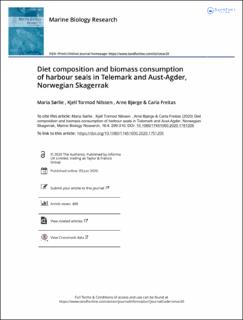Diet composition and biomass consumption of harbour seals in Telemark and Aust-Agder, Norwegian Skagerrak
Peer reviewed, Journal article
Published version
Permanent lenke
https://hdl.handle.net/11250/2682796Utgivelsesdato
2020Metadata
Vis full innførselSamlinger
- Articles [3009]
- Publikasjoner fra CRIStin [3056]
Sammendrag
To explore ecosystem dynamics and functions it is vital to obtain knowledge on predator–prey relations. Harbour seals are piscivorous predators that can come into conflict with fisheries. Recently, as the Skagerrak and Kattegat population of harbour seals has increased, claims have emerged that seals are depleting coastal cod populations. The diet of harbour seals in Norwegian Skagerrak was investigated based on otolith identification from scats. The overall seal diet included 20 different fish species/groups. The most important prey (combined index Q i ) were haddock/pollack/saithe (32.7%), genus Trisopterus (Norway pout/poor cod/bib, 12.5%), plaice (12.4%) and herring (10.0%). Plaice also had the largest biomass (24.1%). Gadoids and pleuronectids comprised 88.6% of the diet (combined index Q i ) and 87.1% in terms of biomass. Cod constituted 0.7% (combined index Q i ) of the overall diet and 2.3% in terms of biomass. Fish length estimates showed that seals generally prefer small fish below minimum allowed landing size. Estimated total amount of fish consumed was 315 tons per year and was dominated by non-commercial species. Annual cod consumption was an estimated 7.1 tons, representing 5% of annual cod landings, suggesting that competition between local fisheries and harbour seals is limited.
